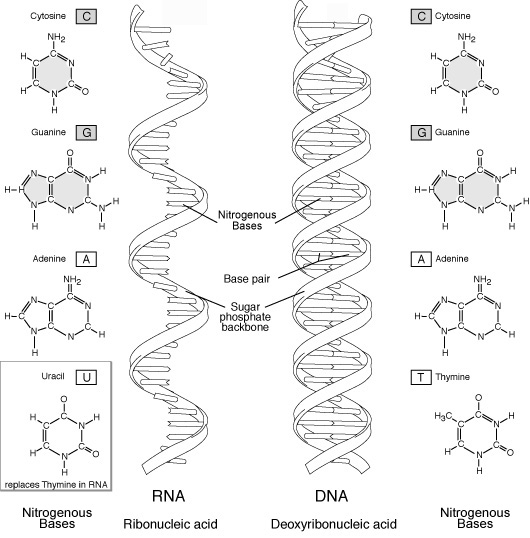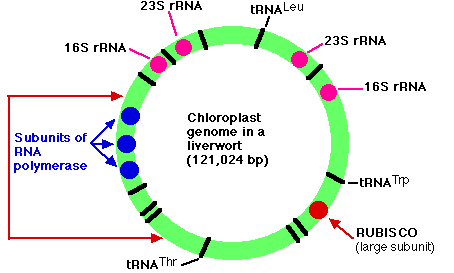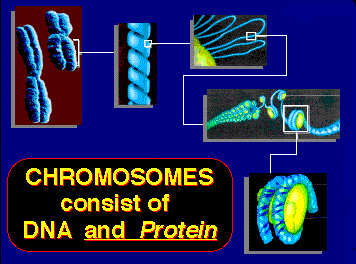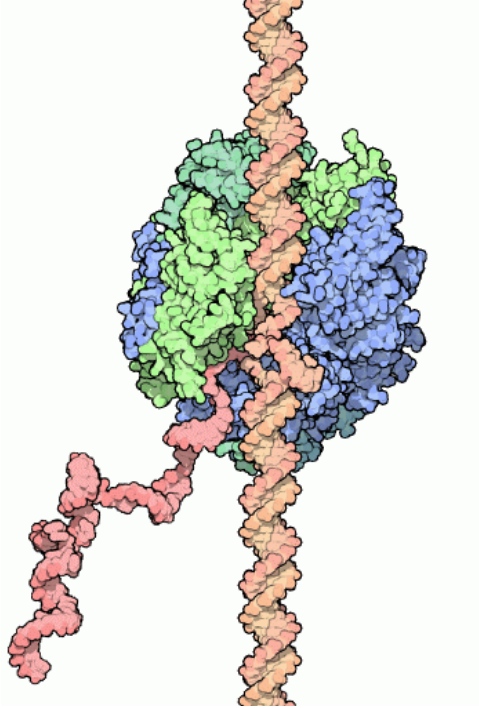
Ribonucleic Acid
There is more to this molecule that can replicate itself, than the three simple letters might suggest. Much like deoxyribonucleic acid or DNA, RNA is made of nitrogen bases. But In RNA the bases are adenine, guanine, cytosine & uracil, instead of thymine (as in DNA). While RNA is less stable than DNA it handily plays many roles in assuring life.
Why does the removal of the cell's nucleus not have an immediate impact on the rate at which proteins are produced?
"Now (late 1950s) we realized RNA could come in several different forms..."
James D. Watson, DNA, p. 72.
 There are too many kinds of RNA not to peak your curiosity.
There are too many kinds of RNA not to peak your curiosity.
Why does it occur in such a wide variety of forms?
Once thought to translate the base pair sequences of DNA, shown here on below, as the "Genetic Code," RNA turns out to be a master builder of organelles or tiny bodies within larger cells as well as the cells themselves.
RNA acts as a "go between," an arranger, and an editor among other things, as it behaves in such a manner as to greatly influence the governing of cellular behavior.
RNA is Coded for in the Genome |
Chromosomes comprise the Genome |
|---|---|
 |
 |
| Ribose a sugar is the marker for RNA | RNA interprets the DNA code where appropriate for ribosomes to build the proteins that perform the very functions that store and retrieve DNA. |
RNA is a versatile molecule. In its most familiar role, RNA acts as an intermediary, carrying genetic information from the DNA to the machinery of protein synthesis. RNA also plays more active roles, performing many of the catalytic and recognition functions normally reserved for proteins. In fact, most of the RNA in cells is found in ribosomes – our protein-synthesizing machine – and the transfer RNA molecules used to add each new amino acid to growing proteins. In addition, countless small RNA molecules are involved in regulating, processing and disposing of the constant traffic of messenger RNA. The enzyme RNA polymerase carries the weighty responsibility of creating all of these different RNA molecules. Ribonucleic Acid the molecule that acts as an enzyme and automatically replicates Messenger RNA mRNA
mRNA shape is not important the sequence of base pairs is Double stranded RNA related to RNAi (RNA interference)
|
"By 1966, what each of the sixty-four codons specifies (in other words the genetic code itself) had been established" James D. Watson, DNA, p. 76. |
a variety of functional roles | transfer RNA | RNAi or interference | RNA polymerase
Ticker tape analogy
". . . ribosomes were, in effect, molecular factories. Messenger RNA passed between the two ribosomal sub-units like ticker tape being fed into an old-fashioned computer."
"From DNA to protein. DNA is transcribed in the nucleus to messenger RNA (mRNA), which is then exported to the cytoplasm for translation into protein. Translation occurs in ribosomes: transfer RNAs (tRNA) complementary to each base pair triplet codon in messenger RNA deliver amino acids, which are bonded together to form a protein chain."
James D. Watson, DNA, pp. 73, 77.
a variety of functional roles | transfer RNA | RNAi or interference | RNA polymerase
tRNA is a small 76 base long molecule folded into peculiar shapes.
Transfer and Messenger RNA types
Each tRNA relates has a specific amino acid sequence attached to it and recognizes a particular amino acid codon sequence of three base pairs of a mRNA.
The tRNA acts to transfer a base pair sequence of mRNA into an Amino Acid sequence.
Ribozymes as many as 1,500 varieties in the five kingdoms, several hundred nucleotides long.
Hammerhead ribozymes – 40 sequences long are the smallest RNA molecule –as yet—found, usually in viruses that infect plants. It cuts DNA sequences.
√ Hepatitis Delta Virus cleaves DNA is about 90 nucleotides long (HDV)
√ Ribonuclease P, a ribonucleoprotein that is 90 nucleotides long
A Ribosome is actually three ribonucleoproteins that synthesize proteins.
“RNA does a lot of different things” based on its single stranded structure, variable length and structure or shape.
RNA probably predates DNA. Moves about where DNA remains hidden in nucleosomes of eukaryotic organisms.
http://www.hhmi.org/biointeractive/rna/rnadiversity/index.html, 11-16-05 9:23PM
RNAi turns off certain gene expression, halting the replication of proteins by ribosomes.
RNA interference and translational control
RNA interference (RNAi) represents an evolutionary conserved cellular defense mechanism for controlling the expression of alien genes in filamentous fungi, plants, and animals. It is caused by sequence-specific mRNA degradation, and is mediated by double-stranded RNA (dsRNA) homologous in sequence to the target RNA. dsRNA is often a byproduct of viral replication or is formed by aberrant transcription from genetic elements after random integration in the host genome.
RNA polymerase

The RNA Factory
RNA polymerase is a huge factory with many moving parts. The one shown here, from PDB entry 1i6h, is from yeast cells. It is composed of a dozen different proteins. Together, they form a machine that surrounds DNA strands, unwinds them, and builds an RNA strand based on the information held inside the DNA. Once the enzyme gets started, RNA polymerase marches confidently along the DNA copying RNA strands thousands of nucleotides long.
Accuracy
As you might expect, RNA polymerase needs to be accurate in its copying of genetic information. To improve its accuracy, it performs a simple proofreading step as it builds an RNA strand. The active site is designed to be able to remove nucleotides as well as add them to the growing strand. The enzyme tends to hover around mismatched nucleotides longer than properly added ones, giving the enzyme time to remove them. This process is somewhat wasteful, since proper nucleotides are also occasionally removed, but this is a small price to pay for creating better RNA transcripts.
Overall, RNA polymerase makes an error about once in 10,000 nucleotides added, or about once per RNA strand created
RNA is critically needed for DNA code to be interpreted & form the requisite proteins to create and maintain living tissues.
"Francis Crick proposed a solution to this paradox, suggesting that RNA predated DNA. He imagined RNA to be the first genetic molecule, at a time when life was RNA-based...."
"Instead peptide bond formation is catalyzed (enzyme acting) by RNA."
• "RNA is both chicken and egg." That is to say it is both capable of storing a and replicating genetic information, but also acts as a protein in that "it can catalyze critical chemical reactions").
• "RNA is an evolutionary heirloom."
"A process may be carried out in a certain way simply because it first evolved that way, not because that is absolutely the best and most efficient way."
James D. Watson, DNA, pp. 83, 84-85.
a variety of functional roles | transfer RNA | RNAi or interference | RNA polymerase
![]() "
"
More about RNA see:
http://www.odec.ca/projects/2004/mcgo4s0/public_html/t3/RNA.html.
![]()
Genetics related files | Science subject index | Home page start | Vocabulary | Gallery
Genetics | Science Index | Site-marker Analysis | Population Index | Global Warming Index | Nature Index | Brief